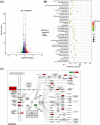Penehyclidine Hydrochloride Protects Rat Cardiomyocytes from Ischemia- Reperfusion Injury by Platelet-derived Growth Factor-B
- PMID: 35838232
- PMCID: PMC10236564
- DOI: 10.2174/1386207325666220715090505
Penehyclidine Hydrochloride Protects Rat Cardiomyocytes from Ischemia- Reperfusion Injury by Platelet-derived Growth Factor-B
Abstract
Aims and objective: The lack of effective treatments for myocardial ischemiareperfusion (MI-R) injury severely restricts the effectiveness of the treatment of ischemic heart disease. In the present research, we aimed to investigate the protective effect and molecular mechanism of penehyclidine hydrochloride (PHC) on MI-R cells.
Methods: Cell viability was quantified using CCK8. Cell apoptosis was analyzed using flow cytometry. Western blot and Elisa assays were used for the detection of target proteins.
Results: PHC pretreatment attenuated the inhibition of cell viability and decreased the percentage of apoptosis induced by simulated ischemia reperfusion (SIR). Platelet-derived growth factor B (PDGF-B) and its downstream AKT pathway were activated in PHC pretreated cells. After siRNAPDGF- B transfection, cell viability was inhibited and apoptosis was activated in PHC pretreated SIR cells, suggesting that PHC protected cells from SIR. PDGF-B knockdown also increased the levels of CK, LDH, IL-6 and TNF-α in PHC pretreated SIR cells. The effect of AKT inhibitor on H9C2 cells was consistent with that of PDGF-B knockdown.
Conclusion: PHC pretreatment can protect cardiomyocytes from the decrease of cell activity and the increase of apoptosis caused by reperfusion through up-regulating PDGF-B to activate PI3K pathway. Our study indicates that PHC is a potential drug to protect cells from reperfusion injury and PDGF-B is a potential target for preventing MI-R injury.
Keywords: Apoptosis; H9C2; cell viability; inflammatory factors; myocardial ischemia-reperfusion injury; penehyclidine hydrochloride.
Copyright© Bentham Science Publishers; For any queries, please email at epub@benthamscience.net.
Conflict of interest statement
The authors declare no conflict of interest financial or otherwise.
Figures





Similar articles
-
Penehyclidine hydrochloride protects against anoxia/reoxygenation injury in cardiomyocytes through ATP-sensitive potassium channels, and the Akt/GSK-3β and Akt/mTOR signaling pathways.Cell Biol Int. 2020 Jun;44(6):1353-1362. doi: 10.1002/cbin.11329. Epub 2020 Mar 16. Cell Biol Int. 2020. PMID: 32125033
-
Magnesium lithospermate B improves myocardial function and prevents simulated ischemia/reperfusion injury-induced H9c2 cardiomyocytes apoptosis through Akt-dependent pathway.J Ethnopharmacol. 2014;151(1):714-21. doi: 10.1016/j.jep.2013.11.036. Epub 2013 Dec 1. J Ethnopharmacol. 2014. PMID: 24296090
-
α-Lipoic acid reduces infarct size and preserves cardiac function in rat myocardial ischemia/reperfusion injury through activation of PI3K/Akt/Nrf2 pathway.PLoS One. 2013;8(3):e58371. doi: 10.1371/journal.pone.0058371. Epub 2013 Mar 7. PLoS One. 2013. PMID: 23505496 Free PMC article.
-
25-Hydroxyl-protopanaxatriol protects against H2O2-induced H9c2 cardiomyocytes injury via PI3K/Akt pathway and apoptotic protein down-regulation.Biomed Pharmacother. 2018 Mar;99:33-42. doi: 10.1016/j.biopha.2018.01.039. Epub 2018 Jan 8. Biomed Pharmacother. 2018. PMID: 29324310
-
Nerve growth factor protects the ischemic heart via attenuation of the endoplasmic reticulum stress induced apoptosis by activation of phosphatidylinositol 3-kinase.Int J Med Sci. 2015 Jan 1;12(1):83-91. doi: 10.7150/ijms.10101. eCollection 2015. Int J Med Sci. 2015. PMID: 25552923 Free PMC article.
Cited by
-
Penehyclidine hydrochloride alleviates lung ischemia-reperfusion injury by inhibiting pyroptosis.BMC Pulm Med. 2024 Apr 26;24(1):207. doi: 10.1186/s12890-024-03018-5. BMC Pulm Med. 2024. PMID: 38671448 Free PMC article.
References
Publication types
MeSH terms
Substances
LinkOut - more resources
Full Text Sources
Research Materials

